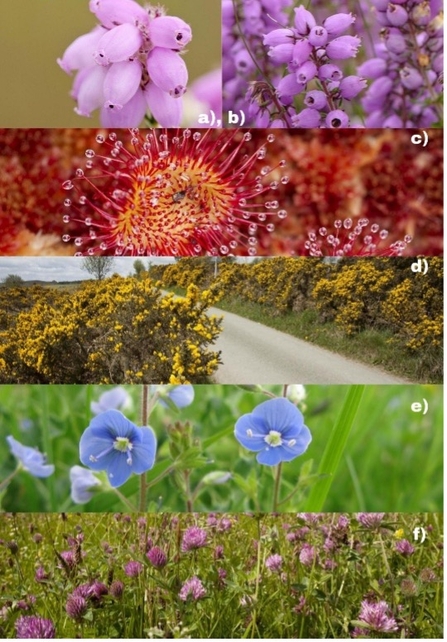
Dominant plant species in Chobham Common:
a) Cross-leaved Heath (Erica tetralix)
b) Bell Heather (Erica cinerea)
c) Round-leaved Sundew (Drosera rotundifolia)
d) Common Gorse (Ulex europaeus)
e) Germander Speedwell (Veronica chamaedrys)
f) Red Clover (Trifolium pratense)
Since the eighteenth century, lowland heath and grassland ecosystems have been in decline in the UK. These ancient cultural landscapes have been shaped by human activities and climatic conditions throughout the years. Much of the remaining parts of these habitats are now designated as National Natural Reserves and remain protected. Chobham Common is a great example of an area which contains an important portion of the remaining lowland heath in the UK. This reserve is currently managed by Surrey Wildlife Trust.
As part of their conservation efforts, Surrey Wildlife Trust has implemented rotational cattle grazing as a management tool to improve soil health, control shrub vegetation and promote the growth of native plant species in the area such as Cross-leaved Heath, Bell Heather and Red Clover. Two years ago, Surrey Wildlife Trust introduced Nofence grazing as a management tool. This technology consists of a virtual fence system, paired with GPS collars, which are attached to the cow's neck and prevent it from going outside of the established boundaries, eliminating the costs of physical fences.
In this project, and as part of my Masters in Environmental Management, I analysed data from GPS collars in four different areas delimited by virtual fencing. The database contained data from June 2023 to May 2024. I analysed parameters such as position coordinates and time, which I then used to obtain data about the following:
- Where do cows spend most of their time?
- How many hours a day do cows usually spend resting, and how many hours do they remain active? (grazing, walking, standing)
- Are these activity patterns normal and similar between pastures?
While the total hours that cattle spent resting or being active were within the normal range for a healthy free-range cow, the activity patterns between each pasture showed significant differences likely because of the following:
- Pastures were active in different seasons throughout the year, mostly during summer and spring, causing high variability of cow activity during each season. Daylight hours were not the same during each season, and this resulted in differences in resting time and active time.
- The areas for each pasture were significantly different.
- Since area and seasonality differed, forage availability also influenced these differences. In some pastures, cows had to walk longer distances in search of food.
Next I obtained satellite images from different sources to compare vegetation cover before and after periods of grazing. The results suggested that the cows' activity, especially active time, does have a positive impact on vegetation regrowth. This means that after a cow grazes in a pasture, this area will recover from grazing pressure, promoting the growth of native species and aiding in conservation efforts. To visualise this more clearly I created coloured heat maps that indicate vegetation health in each pasture and that include cows' positions when resting and when active. The vegetation health index ranges from 0 to approximately 0.5, which tells us that higher values indicate more vegetation cover in the area. It is clear that the areas where cows conglomerate the most have higher indexes of vegetation cover after being grazed.
Overall, this study allowed me to understand the importance of grazing in today's conservation efforts, as well as to realise that external factors can affect cows' activity patterns and therefore, grazing behaviour.
To continue gaining a deeper understanding on this matter, it would be highly recommended to perform the same analysis using other data such as accelerometer data (which can be obtained from Nofence collars). Analysing this data would help to better classify cows' behaviour, such as grazing, defecating, running, etc., which eventually can give us indicators on cows' health and their impact in the ecosystem.
I really enjoyed being part of this project, supported by Surrey Wildlife Trust, and I hope that this study serves as a starting point on the research of conservation grazing on Chobham Common and other grassland ecosystems.
By Regina

